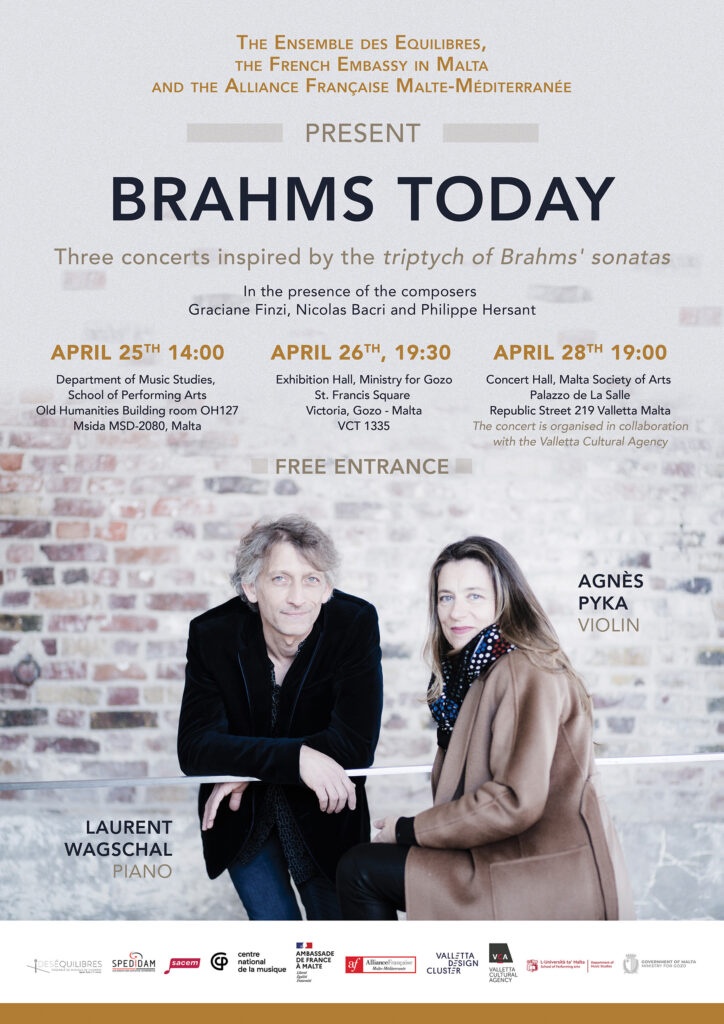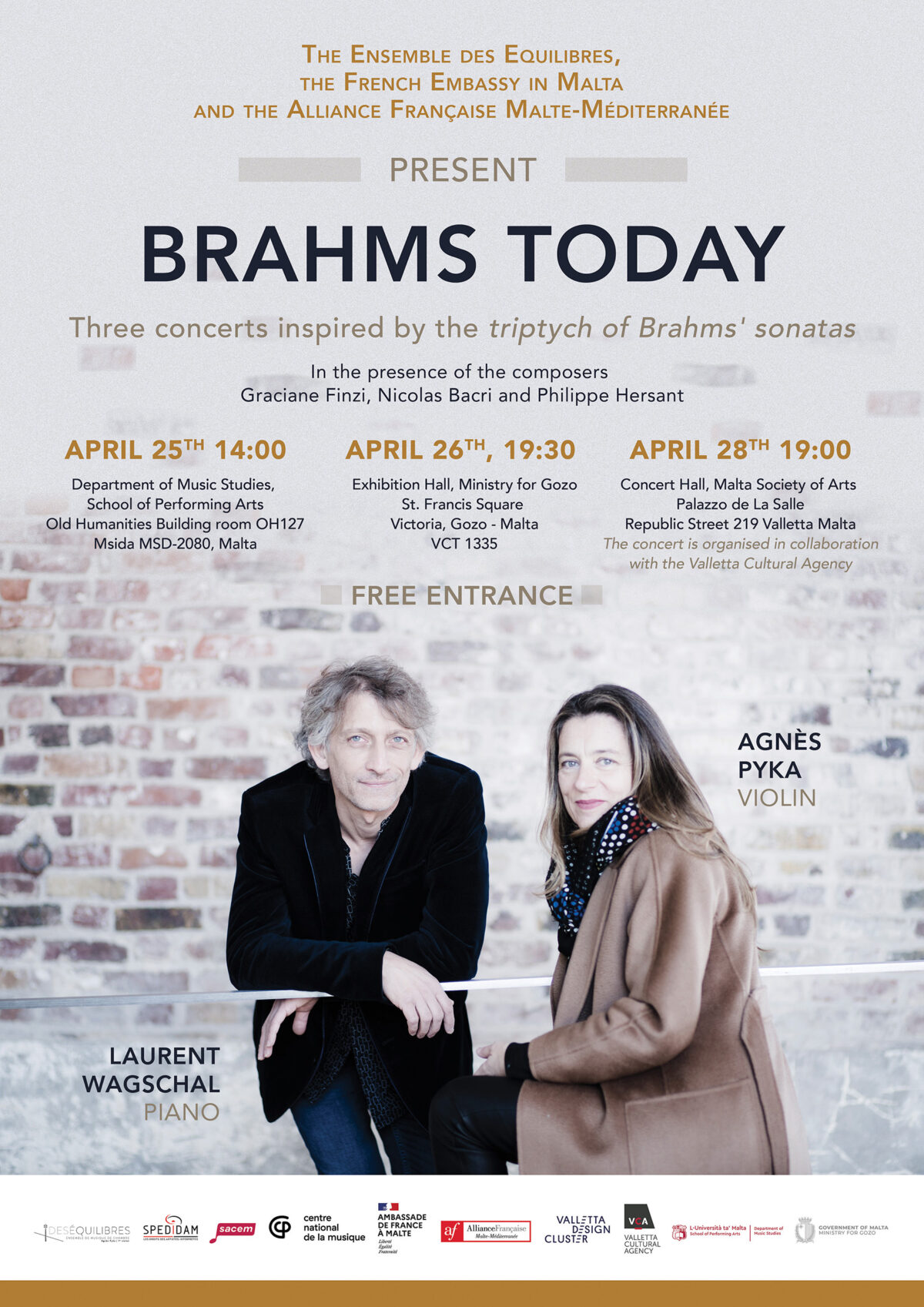Brahms Today : three exceptional concerts !
The Alliance Française Malte-Méditerranée invites you to an upcoming event, Brahms Today, organised in collaboration with the French Embassy in Malta and the Ensemble des Equilibres.

The event will feature an exclusive commission from the Ensemble Des Equilibres which will take the form of three exceptional concerts that will showcase the work of three contemporary composers, Graciane Finzi, Nicolas Bacri, and Philippe Hersant, as they provide their unique perspective on Brahms’ triptych of sonatas.
Each composer has taken inspiration from one of Brahms’ sonatas, resulting in three exceptional and original creations. The unique interpretation of Brahms’ work by each composer is highlighted in a collaborative work:
– Philippe Hersant has chosen to write on Brahms’ first sonata, – Nicolas Bacri has chosen to write on the second sonata of Brahms, – Graciane Finzi has chosen to write on Brahms’ third sonata
Programme of concert : – Philippe Hersant Sonata Regenlied – 2018 for violin and piano
– Nicolas Bacri, Sonata No. 4 op. — 2017-18 for violin and piano (Editions Alphonse Leduc)
– Graciane Finzi, Sonate Winternacht – 2018 for violin and piano
Two wonderful artists will perform these works: Agnès Pyka (violin) and Laurent Wagschal (piano) !
The event will take place on three days :
April 25th 14:00 University of Malta
April 26th, 19:30 Exhibition Hall, Ministry for Gozo
April 28th 19:00 Concert Hall, Malta Society of Arts
Free entrance. No booking is required. The composers will be present as well ! It is an incredible opportunity for music lovers to experience the works of contemporary composers inspired by one of the greatest composers of all time, Brahms.
The concerts are organized in partnership with : the Ensemble des Equilibres, the Department of Music Studies of the University of Malta, the Alliance française Malte Méditerranée, the Valletta Cultural Agency and the Ministry for Gozo.
NOTES OF INTENT
PHILIPPE HERSANT – Sonata Regenlied for violin and piano (2018)
To Agnès Pyka and Laurent Wagschal
Since a long time, I like to write pieces that are inspired by historical works. I did this several times, with my Trio (a piece based on “The Bells of St. Genevieve by Marin Marais), with my 4th string quartet, that draws its inspiration from Beethoven’s 8th Quartet, or with my Psaum 130 that recalls Bach’s chorale “Aus tiefer Not”.
Therefore, I accepted with great pleasure the Des Equilibres ensemble’s proposal to write a piece for violin and piano echoing one of Bach’s three sonatas.
As for me, I would like to choose “Regenlied” as an inspiration, which is a wonderful melody used by Brahms in the finale of his First Sonata.”
NICOLAS BACRI – Sonata for violin and piano n°4, Opus 148 (2017-2018)
To Agnès Pyka and Laurent Wagschal
“I discovered Brahms when I was about 8-10 years old with the Quintet in F minor Op.34. I loved it. Later, my schoolteacher introduced me to Russian music. Stravinsky became my main interest after “The Five”. It was only at the age of seventeen that I became truly familiar with Brahms’ symphonies, and so a love for his chamber music followed along. His chamber music will forever remain an unmatched landmark in terms of balance between tradition and innovation: for its language, depth, and communicability, for its aesthetics, instrumentality, and vocal style, as well as for its approach of sound design.
Brahms’ chamber music is part of a series of masterpieces such as Bach, Haydn, Mozart, Beethoven, Schubert, Mendelssohn, and Schuman. These pieces encourage me to give my very best. It is with great joy that I accepted Agnès Pyka and Laurent Wagschal’s proposal to write a new sonata for violin and piano.
The sonata is a music genre that triggered my esthetic questioning at the end of the 80’s and led me to leave the ranks of the post-serial musicians. My first sonata, Op.40, dates from 1994. It emphasizes melodic dominance and sketches a reconquest of the classical bi-thematic sonata form. The second sonata, Op. 75 was written in 2002. It emphasizes the specific formal option of the sonata and explores the rondo form in the “Finale”. The third, Op. 138 is called “Torso” due to its contours that seem sculpted by a chisel. Besides, it is, just as some of my main works, written as a single piece. It includes different movements linked together and it forms a whole which can be interpreted as a synthesis between the sonata form and free variations on two additional themes.
The fourth sonata subtitle will be “Frei aber Einsam und Froh”; as a reference to Joseph Joachim’s motto (Frei aber Einsam) – which was used by Schumann, Dietrich and Brahms for the Sonata F.A.E. – merged with Brahms’ “Frei aber Froh”, the title of the first movement of his third sonata. This will provide the piece main pattern: F, A, E, F sharp. Any similarity to the author’s personal life is purely coincidental.”
GRACIANE FINZI – Winternacht for violin and piano (2018)
To Agnès Pyka and Laurent Wagschal
“When Agnès Pyka asked me to write a piece for violin and piano around Brahms’ sonatas, I was immediately thrilled by the idea for multiple reasons.
Firstly, I deeply appreciated the talent Agnès Pyka and Laurent Wagschal during several concerts where they performed my works. In addition, drawing on such a musical masterpiece for piano and violin as Johannes Brahms’s three sonatas is at the same time challenging and rewarding.
I’m truly delighted about this project, especially because of the collaboration with the two other composers: Philippe Hersant and Nicolas Bacri.”

